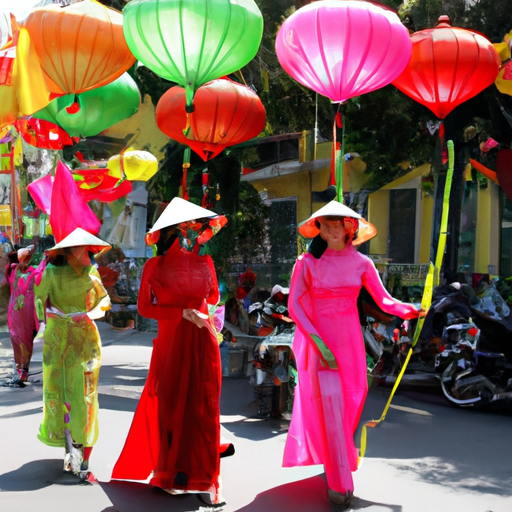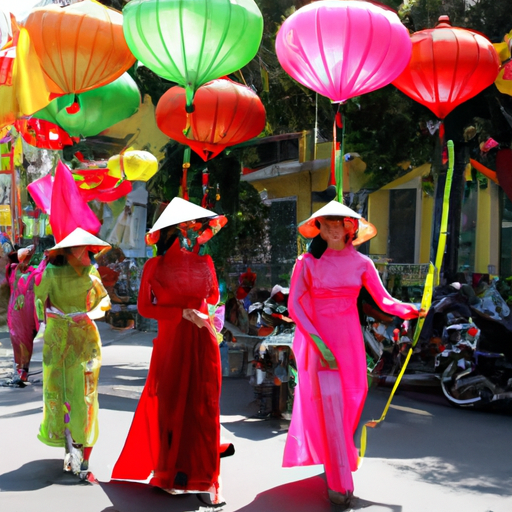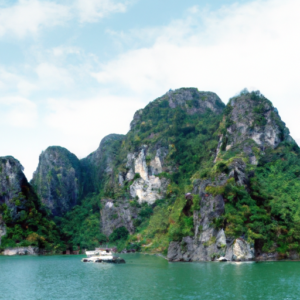In this article, you’ll learn about the rich cultural traditions and vibrant festivals that shape Vietnam’s heritage. From the Tet holiday that marks the Lunar New Year to the Mid-Autumn Festival celebrated with lanterns and mooncakes, you’ll discover the different customs and rituals that make these events so special. We’ll also explore other cultural traditions like the tea ceremony and the art of water puppetry, giving you a deeper understanding of Vietnamese culture. So get ready to immerse yourself in the beauty and excitement of Vietnam’s cultural traditions and festivals. Vietnam is a country with a rich and diverse cultural heritage, which is reflected in its traditional customs, festivals, and practices. Whether it’s celebrating the Lunar New Year with Tet Nguyen Dan, or experiencing the vibrant ethnic minority festivals, there is always something exciting happening in Vietnam. In this article, we will explore the various cultural traditions and festivals that make Vietnam a truly unique and fascinating country.
Traditional Festivals
Tet Nguyen Dan
Tet Nguyen Dan, commonly known as Tet, is the most important and widely celebrated festival in Vietnam. It marks the arrival of the Lunar New Year and is a time for families to gather, exchange gifts, and pay respects to their ancestors. The streets are adorned with colorful decorations, and traditional customs such as cleaning the house, preparing special meals, and offering food to the ancestors are observed. This festival truly showcases the spirit of Vietnamese culture and brings the community together in joyous celebration.
Mid-Autumn Festival
The Mid-Autumn Festival, also known as Tet Trung Thu, is a favorite festival among children. It takes place on the 15th day of the eighth lunar month and is celebrated with lantern processions, lion dances, and the gifting of mooncakes. Children walk through the streets, carrying beautifully crafted lanterns, and enjoy the variety of activities and performances. This festival not only celebrates the harvest season but also promotes family unity and the well-being of children.
Lunar New Year
The Lunar New Year, known as Tết Nguyên Đán in Vietnamese, is the biggest festival in Vietnam. Celebrated based on the lunar calendar, it marks the arrival of spring. During this time, families come together, visit temples, and enjoy traditional dishes such as banh chung (sticky rice cake) and dua hanh (pickled onion). The streets are filled with vibrant decorations and colorful displays, including the famous peach blossom trees. This festival is a time of reflection, family, and renewal, and is considered the most important annual event in Vietnam.
Hung Kings Temple Festival
The Hung Kings Temple Festival is a tribute to the legendary founders of Vietnam, the Hung Kings. Held annually on the 10th day of the third lunar month, this festival is a time to honor and remember the contributions of these mythical figures. The rituals and ceremonies include processions, traditional music and dance performances, and the offering of incense. This festival not only reinforces the cultural identity of the Vietnamese people but also serves as a reminder of their roots and history.
Religious Festivals
Buddha’s Birthday
Buddha’s Birthday, or Vesak, is a significant religious festival celebrated by Buddhists all over the world, including Vietnam. It commemorates the birth, enlightenment, and death of Gautama Buddha. During this festival, temples are adorned with colorful decorations, and devotees engage in acts of merit, such as offering food, lighting candles, and releasing caged animals as a symbol of compassion. The atmosphere is one of tranquility and spiritual reflection.
Christmas
While Vietnam is predominantly a Buddhist country, Christmas is also widely celebrated. The festive spirit can be felt in the major cities, with streets decorated with Christmas lights and trees. Christians attend midnight Mass, exchange gifts, and enjoy festive meals with their loved ones. This celebration not only showcases religious tolerance but also provides an opportunity for people to come together and spread joy and goodwill.
Lantern Festival
The Lantern Festival, also known as Thien Mu Pagoda Festival, takes place on the 15th day of the first lunar month. It is a time to pray for peace and good fortune. Thousands of colorful lanterns are released into the sky, creating a mesmerizing display. In addition to the lanterns, there are also dragon boat races, traditional music and dance performances, and various games and activities for all to enjoy.

Ethnic Minority Festivals
Vietnam is home to 54 distinct ethnic minority groups, each with its own unique cultural traditions and festivals. Here are a few notable ones:
Khau Vai Love Market
The Khau Vai Love Market, held annually on the 26th and 27th day of the third lunar month, is a special event for ethnic minority groups in northern Vietnam. It is a place where former lovers can meet, reminisce, and spend time together. The market is filled with traditional music, dancing, and trading, creating a lively and joyous atmosphere.
Gong Festival
The Gong Festival is a significant cultural event celebrated by several ethnic minority groups in the Central Highlands of Vietnam. It showcases the art of playing gongs, which are considered sacred instruments that connect the physical and spiritual worlds. The festival features traditional music and dance performances, along with exciting gong competitions. It is a captivating spectacle that highlights the traditional arts and customs of the region.
Long Tong Festival
The Long Tong Festival, celebrated by the Tay ethnic minority, is an agricultural festival that marks the beginning of a new farming season. It is held on the 10th day of the first lunar month and involves various rituals to thank the gods for a bountiful harvest. The festivities include traditional music and dance performances, the offering of food and prayers, and the sharing of traditional dishes within the community.
Traditional Customs and Practices
Vietnamese culture is steeped in a variety of customs and practices that have been passed down through generations. These customs play an important role in shaping the Vietnamese identity.
Ancestor Worship
Ancestor worship is a deeply ingrained practice in Vietnamese culture. Families often have ancestral altars in their homes where they pay respects to their ancestors, seeking guidance and protection. Offerings of food, incense, and prayers are made to ensure the well-being of both the living and deceased family members.
Tea Ceremony
The tea ceremony is an integral part of Vietnamese culture and is often performed during special occasions or to welcome guests. It involves the art of preparing and serving tea with grace and precision, emphasizing harmony and tranquility. The ceremony represents respect, hospitality, and the appreciation of nature.
Wedding Ceremonies
Wedding ceremonies in Vietnam are a blend of traditional customs and modern influences. They usually include rituals such as the exchange of gifts, paying respects to the ancestors, and the ceremonial procession of the bride and groom. The ceremonies are often vibrant and colorful, with traditional music and dances adding to the festive atmosphere.
New Year’s Customs
The Vietnamese New Year, known as Tết, is a time when many customs and superstitions are observed. These include cleaning the house to remove bad luck, offering incense to ancestors, and avoiding negative behaviors such as arguing or crying. The belief is that these practices will ensure a prosperous and auspicious start to the new year.

Cuisine and Food Customs
Vietnamese cuisine is renowned for its bold flavors, fresh ingredients, and vibrant colors. Food customs and traditions are an important part of Vietnamese culture and family gatherings.
Pho
Pho is Vietnam’s most famous dish and is a beloved part of the country’s culinary heritage. It consists of a flavorful broth, rice noodles, and various toppings such as beef or chicken. Pho is often eaten for breakfast or as a comforting meal during the cooler months.
Banh Mi
Banh Mi is a Vietnamese sandwich with a French influence, reflecting Vietnam’s colonial history. It typically consists of a crispy baguette filled with various fillings such as grilled meats, pickled vegetables, and fresh herbs. Banh Mi is a popular street food and is enjoyed throughout the day.
Spring Rolls
Spring rolls, also known as cha gio or nem, are a quintessential dish in Vietnamese cuisine. These crispy rolls are filled with a mixture of vegetables, meats, and sometimes noodles. They are often served as appetizers or as part of a larger meal.
Rice Paper Rolls
Rice paper rolls, or goi cuon, are another popular dish in Vietnamese cuisine. They consist of fresh herbs, vermicelli noodles, and a choice of fillings such as shrimp or pork, wrapped in delicate rice paper. Rice paper rolls are typically served as a refreshing and healthy appetizer.
Art and Performance Forms
Vietnamese culture boasts a variety of unique art and performance forms that have been cherished for centuries.
Water Puppetry
Water puppetry, or mua roi nuoc, is a traditional form of Vietnamese puppet theater that dates back to the 11th century. It involves the use of wooden puppets that are controlled on the surface of a water stage. Colorful performances depicting traditional folk tales, historical events, and daily life are accompanied by live music and singing.
Traditional Music
Vietnamese traditional music, known as nhạc cổ truyền, showcases the country’s cultural heritage and diversity. It includes various musical genres, such as ceremonial music, classical music, and traditional folk music. These performances often feature traditional instruments such as the dan bau (monochord), the dan tranh (zither), and the dan nhi (two-string fiddle).
Dance Forms
Vietnamese traditional dance forms are characterized by their elegance, grace, and expressive movements. The most well-known dance form is the ao dai dance, which features performers dressed in the country’s traditional attire, the ao dai. Other dance forms include fan dancing, ribbon dancing, and bamboo pole dancing. These performances often depict cultural stories, historical events, or daily activities.
Clothing and Fashion
Vietnamese clothing and fashion have evolved over centuries, influenced by the country’s history and cultural diversity.
Ao Dai
The ao dai is Vietnam’s national costume and is worn by both men and women on special occasions. It is a form-fitting garment with a high collar and long sleeves for women, and a looser fit for men. The ao dai represents elegance and grace and is often seen as a symbol of Vietnamese identity.
Non La
The non la, or conical hat, is an iconic symbol of Vietnam. It is made of palm leaves and bamboo and is worn by both men and women to protect against the sun and rain. The non la is not only a practical accessory but also represents the simplicity and beauty of Vietnamese culture.
Silk Traditions
Vietnamese silk is renowned for its quality and intricate designs. It has been woven and dyed using traditional methods for centuries. Silk garments, such as ao dai and traditional dresses, are treasured for their vibrant colors and exquisite craftsmanship. The silk industry is a significant part of Vietnam’s cultural heritage and continues to thrive today.
Significance of Festivals and Traditions
The festivals and traditions in Vietnam hold great significance and play a vital role in preserving the country’s cultural heritage.
Preservation of Cultural Heritage
The celebrations and customs passed down through generations help preserve and promote Vietnam’s rich cultural heritage. These festivals provide a platform for showcasing traditional arts, music, dance, and costumes, allowing future generations to appreciate and carry forward these customs.
Promotion of Unity and Harmony
Festivals in Vietnam bring people together, strengthening social bonds and promoting a sense of unity and harmony. They serve as a reminder of values such as respect, gratitude, and communal spirit. Festivals provide an opportunity for people from different backgrounds to come together and celebrate as one.
Reflection of Vietnamese Identity
The festivals and traditions of Vietnam reflect the country’s unique identity and serve as a source of pride for its people. The customs and practices observed during these festivals showcase the values, beliefs, and history of Vietnam. They remind the Vietnamese people of their roots and help define their cultural identity.
Influence of Chinese and French Cultures
Vietnam’s cultural traditions have been influenced by its historical ties with neighboring countries, particularly China and France.
Chinese Festivals and Traditions
Vietnam shares a border with China, and there are significant Chinese cultural influences in Vietnamese customs and festivals. Many festivals, such as Tet Nguyen Dan and the Mid-Autumn Festival, have roots in Chinese traditions. The exchange of cultural practices has enriched Vietnam’s own traditions and added depth to its cultural diversity.
French Colonial Influence
Vietnam was under French colonial rule for a significant period, which has left a lasting impact on its culture. French influences can be seen in Vietnamese architecture, cuisine, and fashion. The fusion of French and Vietnamese elements has created a unique blend that is often cherished and celebrated in modern Vietnamese culture.
Conclusion
Vietnam is a country with a wealth of cultural traditions and festivals that have been cherished for centuries. The celebrations bring people together, promote unity and harmony, and preserve the country’s diverse cultural heritage. Whether it’s the vibrant Lunar New Year festivities, the enchanting water puppetry performances, or the cultural significance of the traditional customs and practices, Vietnam’s cultural traditions continue to play a significant role in shaping the country’s identity. So next time you visit Vietnam, make sure to immerse yourself in its rich and diverse culture by experiencing the colorful festivals and traditions that make this country truly extraordinary.



